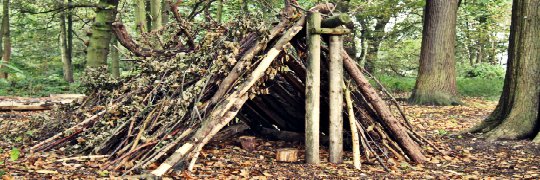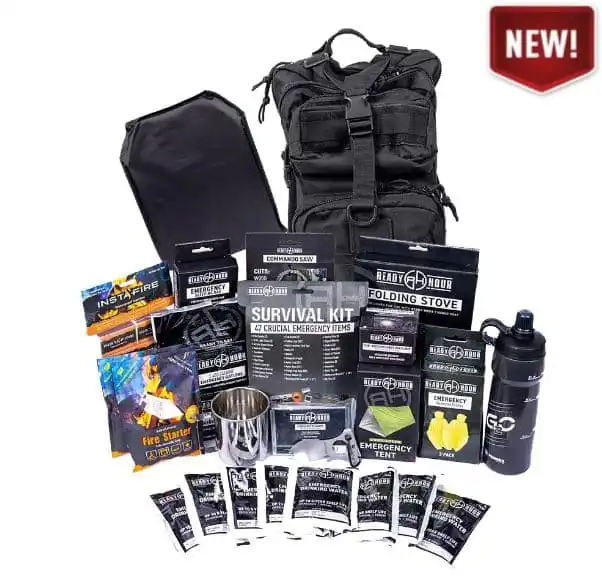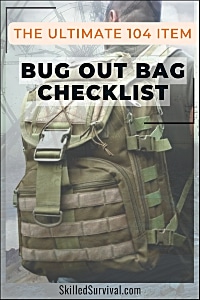
A Complete Bug Out Bag Checklist
One that tells you not only WHAT to add to your pack but WHY.
Because you have to justify everything.
And you must make tough decisions because you can’t take everything.
This bug out bag list ensures you end up with the perfect bug out bag for YOU.
A go bag you can be proud of:
TOPICS IN THIS GUIDE… ↓(click to jump)
- Number 1: A Quality Bag
- Water & Hydration Tools
- Food Supplies & Tools
- Clothes & Warmth Supplies
- Shelter & Bedding Options
- Fire Starting Tools & Gear
- First Aid & Medical Supplies
- Personal Hygiene Items
- Core Survival Tools
- Illumination Tools
- Communication Devices
- Defense Tools / Weapons
- Misc. Tools & Supplies

Want a free 104 item bug out bag checklist?
Click here to instantly download this Complete Checklist PDF. No purchase necessary.↓My EXACT Bug Out Bag Build
A Quality Bag
Before you begin filling your bag, you need a bag, right?
But using that discount duffel found in the back of your closet is NOT a good idea.
Instead, get one with the following qualities:
- Made with thick, tough fabrics
- Includes MOLLE webbing
- Has a chest strap or padded hip straps
- Water-resistant or includes a shell
- High-quality zippers and clips
- Includes a lot of compartments
And if you’re not familiar with MOLLE, watch this short video:
↓ Everything You Need To Know About MOLLE
1. Bug Out Bag
The EVATAC™ Combat Bag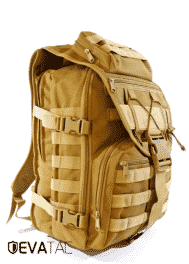
It’s the bag that I chose.
- It’s made with 600D Polyester, which is tough as nails.
- The zippers and clips are heavy-duty and long-lasting.
- The padded shoulder straps keep things comfortable.
- And there is a chest strap that can cinch it down tight (keeping it in place while running)
- There are a total of 10 compartments (to keep your survival gear organized)
By the way, these compartments are waterproof to keep your gear dry.
There’s even a padded compartment that can fit a laptop or other sensitive gear.
The best news is:
At the time of writing, this bag cost a fraction of similar bags.
Interested? Check out my detailed review of The Combat Bag by EVATAC:
↓ The Combat Bag By EVATAC
Once you’ve got your bug-out bag, it’s time to add gear.
Please Note: This list is intended to provide all the possible items you may want to add to your bag.
But if you add everything suggested, it will get way too heavy.
You should pick and choose the essential items that make the most sense for YOU.

Want a free 104 item bug out bag checklist?
Click here to instantly download this Complete Checklist PDF. No purchase necessary.Water & Hydration Tools
For SHTF, you need three ways to purify your water sources.
Because drinking contaminated water will make you sick.
I’m talking about severe dehydration that could even kill you.
What about just carry all the water you’ll need?
Not an option.
Water is extremely heavy, so you’ll have to find it along the way.
That’s why you’ll need purification tools and filters…
2. Stainless Steel Water Bottle
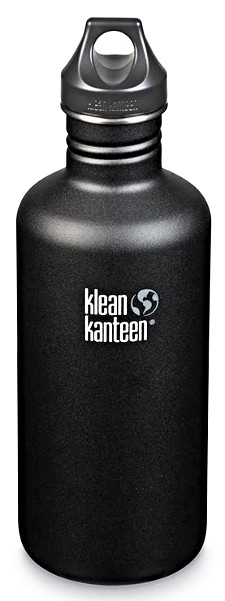
Get a stainless steel one and not plastic.
You can’t boil water in a plastic bottle.
And boiling is the simplest way to purify water.
Double-wall (or even triple-walled) water bottles are also bad.
They make it darn near impossible to boil water over a fire.
And boiling is your “backup” plan when bugging out.
So ONLY want single-walled stainless steel for water bottle.
3. Water Purification Tablets
An alternative method is to carry water purification tablets.
These tablets treat water faster than boiling.
Thus allowing you to keep moving.
Plus, they’re lightweight, so you won’t pay much of a weight penalty.
4. Portable Water Filter
Survival water filters remove particulates from your water, such as:
- dirt
- soot
- bugs
- and most harmful bacteria
Sawyer Mini Water Filter
I recommend getting a couple Sawyer mini water filters.
Not only are they compact and lightweight, but they can filter 100,000 gallons of water!
What makes the Sawyer Mini so powerful is its inline design capabilities.
Use it like a straw or an inline filter to remove 99.999% of harmful bacteria.
Here’s my full video review of the incredible Sawyer Mini.
↓ Sawyer Mini Water Filter Review – Can This Filter 100,000 Gallons?
5. Gravity Water Filter
This is gravity filter is ideal for cleaning larger volumes.
So it’s good for groups or family bug outs.
Use it at stops AND once your family arrives at your bug-out location.

Want a free 104 item bug out bag checklist?
Click here to instantly download this Complete Checklist PDF. No purchase necessary.Bug Out Food Supplies & Tools
Pack some calories.
Just a few essentials to maintain your stamina.
More than that and your bag will get too heavy!
So focus on light, easy-to-prepare foods.
Also plan to take advantage of anything the land can provide.
A few survival tools to:
- Fishing
- Trapping
- Foraging
Note: We’ll cover the tools later on in this list…
6. Calorie Dense Food Bars
Any calorie-dense energy bar will do the trick.
Just read the label and pack the ones that provide the most calories per bar.
These ER Emergency Food Ration Bars pack 2400 calories per bar.
This is exactly what you want.
- They feed your primary energy needs quick.
- And they’re easy to consume on the go.
And you can pack quite several without adding much weight.
Plus, they have a decent shelf life (5+ years).
7. Freeze Dried Meals
Freeze-dried foods are a hot meal in a pouch.
They’re another light food you can add to your checklist.
They only take a few minutes to prepare.
But they’re NOT and “on-the-go” option.
You’ll need to wait for a safe spot to rest.
Just add the contents to boiling water, stir, and eat.
My favorite freeze-dried food for bugging out is Mountain House’s Beef Stroganoff.
I prefer Mountain House because you can cook the meal directly in the pouch (as shown in the video below):
↓ Mountain House Food Review – Is This the Best Go Food?
8. Military Meals (MRE – Meal, Ready to Eat)
If MRE meals are good enough for soldiers, then they are good enough for me.
I do prefer to pack freeze-dried food over MREs.
But if all I had were MREs, I’d be fine with that.
But some people think they taste horrible.
And there’s a long-standing debate about MREs.
Here’s a discussion on this hotly debated topic if you want to dig deeper.
9. Eating Utensils – Spork
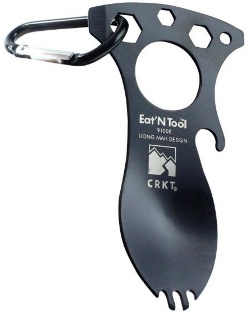
But traditional forks, spoons, knives are too bulky.
Instead, you only need small and light spork.
Get this 1.5 oz multi-tool spork:
It doubles as a multitool!
Multi-tools are always best for survival.
A side note, you won’t need a separate small knife for cooking.
Why? Because you can use your survival knife (a separate checklist item later).
10. Small Collapsible Cup/Bowl
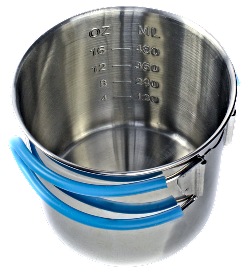
Instead, get a stainless steel cup.
You want one large enough that can double as a bowl.
I like this one because it’s stainless steel.
That way, you can boil water with it in a pinch.
11. Braided Fishing Line
Fish are an excellent source of protein…if you can snag them.
Fishing while on the move is not always the best idea.
It depends on your plan and the current circumstances…
If you do want to try choose braided fishing line.
It’s durable and can take more abuse than regular fishing line.
You won’t need much, so get the small spool.
The bottom line is:
Fishing line is a great survival tool to have in your bag.
It’s light, durable, and can catch fish or help with other survival needs.
12. Fishing Pole (small, collapsing, or pocket)

Like this small fishing rod from Emmrod.
This rod works well (especially for how small it is) and easily fits into a pack.
Take one with you on your next fishing trip so you get experience using it.
13. Yo-Yo Fishing Reels
I recently stumbled on these little devices.
↓ Yo-Yo Fishing Reel In Action
You can set several out, leave them, and come back later.
So you won’t waste precious time actively fishing.
You have better things to do mid-bug out than casting and reeling for hours.
- If you catch a fish or 2, you’re ahead of the game.
- But if you don’t, you didn’t waste any time.
14. Hook, Swivel, Sinker Set
I’ve covered fishing lines and poles.
But without hooks, swivels, and sinkers, you won’t catch anything.
Keep it light, you only need a small number of each.
This little case includes 75 pieces.
You should remove about 2/3 of them before packing, to save weight.
15. Portable Light Weight Stove

You CAN survive without it and save the weight.
It’s your call.
With that said…
- A small stove can boil water faster than over an open fire.
- It also makes your freeze-dried pouch food preparation both easier.
Another consideration is stealth.
Fires can give your position away to others, especially at night.
But a small stove, keep the fire small and hidden.
Note: The Solo Stove Lite is only 9 oz.
And doesn’t require you to pack any fuel!
It works with a few sticks and twigs – saving pack weight!
Watch this video to see how this stove works:
↓ Never Buy Fuel Again! Solo Stove Review
16. Additional Stove Fuel (if necessary)
Depending on your stove, you may need a couple of fuel containers.
Eventually, they will run out.
But if you to your bug out location before they do, you win.
17. Snare Wires
Setting up a few snares overnight.
Maybe you’ll get lucky and snag a squirrel or rabbits on the go.
Snare wires are lighter than traps, so they’re the right choice.
Be forewarned, though:
- They won’t be of much use if you don’t know what you’re doing.
- But EXTREMELY powerful if you do
18. Survival Slingshot
Nowadays, they make some powerful slingshots
It takes some practice, but can kill small game in the forest.
↓ Hunting With A Slingshot
19. Daily Multivitamin Supplement
Stash some vitamins to maintain your overall health.
Your diet will become limited in the wilderness.
So taking a vitamin supplement will keep your mind and body strong.
Bug Out Clothes & Warmth Supplies
Spare clothes take up A LOT of precious pack space.
And weigh more than you think.
So limit additional clothes to a couple of undergarments.
Plan on wearing the same clothes (like a pair of tactical pants) every day.
And then change your undergarments to maintain hygiene.
Remember:
Wardrobe changes are not a luxury you can afford.
20. Fresh Socks
You can’t afford trench foot or severe blisters.
So rotate a fresh pair of socks daily.
The socks I trust with my feet are smart wools.
They are thick, warm, and comfortable, even on long hikes.
Pack one pair and wear one pair.
Wash, dry, and rotate daily.
21. Quick-Drying Undergarments
You want quick-drying undergarments.
They’re designed to dry quickly.
That way, you can wash and tie them to the outside of your pack .
You need one spare set in your pack.
Rotate daily.
22. Sewing Kit

A sewing kit allows you to mend should they rip or tear on the trail.
23. Safety Pins
Safety pins can keep clothes together in a pinch.
Hold a rip together until you can stitch a more permanent patch makes sense.
These safety pins are heavy-duty.
So they work better in tough environments.
24. Survival Gloves
You’ll want a set of gloves when it gets cold.
I pack a set of Mechanix gloves.
Why? Because they’re designed for people who work with their hands.
With these gloves, you can use your survival knife or a firearm without taking them off.
25. Stocking Cap
It’s a myth that we lose the majority of our body heat through our heads.
But it’s still wise to keep your dome covered in the cold.
- Pack a camouflage one to avoid detection in the wild.
- Or a gray one if traveling through a city.
26. Body Warmers
Add a few warming packets to your survival pack, just in case.
Or pack a small pocket electric hand warmer.
Then save them for serious emergencies.,
Like just before the threat of frostbite.
You can’t afford to lose your fingers or toes to frostbite.
THAT would be game over.
27. Rain Poncho with Hood
Nothing drains the heat from your body (and from your soul) than hiking in drenched clothes.
It’s a miserable experience.
And dangerous.
This Princeton study shows that:
“Generally conductive heat loss accounts for only about 2% total loss. However, with wet clothes, the loss is increased 5x.”
So pack a poncho.
Ponchos are thin and light and take up limited space.
- Get one with a hood to keep the rain off your head.
- And a durable one that won’t tear.
It may cost a bit more, but it’s worth it.
Because if you’re cold and wet for long, hypothermia is coming.

Want a free 104 item bug out bag checklist?
Click here to instantly download this Complete Checklist PDF. No purchase necessary.Shelter & Bedding Options
Your choice of survival shelter comes down to personal preference.
I don’t pack a survival tent.
Why? Because the poles and anchors are too heavy.
Instead, I use my survival skills to make a debris shelter.
28. Tarp Shelter

It will:
- Keep you dry
- Break the wind,
- Give you a “safe” space to sleep
So why carry the extra weight of poles?
This Aqua Quest tarp is made for the outdoors.
And it has tons of tie-down grommets.
See how to build a tarp shelter in under 5 minutes:
↓ How To Build A Tarp Shelter & Conquer The Elements
29. Survival Hammock
A quality hammock is another shelter option.
Add a sleeping bag to a hammock, and you’ll be warm, off the ground, and dry.
All you need is a couple of trees and some paracord.
Get one with a built-in mosquito net.
Or check out the latest hammock tent designs.
30. TACT Bivy
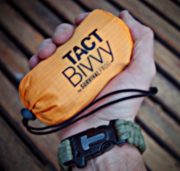
This TACT Bivvy is an emergency survival blanket.
It’s as small and lightweight as you can get.
But will keep you warm and dry even in the worst weather.
I think EVERYONE should put one in their vehicle’s glove box.
Because they save lives.
Get one and add it to your pack.
↓ Best Emergency Shelter – TACT Bivvy Review
31. Sleeping Pad

They put a layer between you and the cold hard ground.
Because laying on the ground sucks the warmth and energy out of your body.
Get this light, durable option.
If you don’t take a pad, plan to add a layer with wilderness debris (i.e., leaves, pine straw, etc.).
32. Zip Ties
Zip ties are an amazing invention.
They are as tough as hell, and allow you to create tight connections.
Some police departments use a zip ties instead of handcuffs.
They have a variety of additional survival uses too.
As far as shelters go, use them to tie branches together to create simple shelters.
33. Paracord Survival Kit
Paracord has so many survival uses.
In the case of shelters, it can tie branches together or attach your tarp to trees.
It can also anchor your hammock.
That’s why you should pack paracord.
OR wear a paracord bracelet on your wrist.
Fire Starting Tools & Gear
Fire is your lifeblood in an emergency.
That’s why you need 3 independent ways to start one.
IT can:
- Purify water
- Cook food
- Keep you warm
- Boost morale
Get 3 unique fire-starting tools and practice with them.
And if you really want up your survival game, learn how to start a fire with sticks.
It takes practice but it’s a powerful skill to master!
↓ How To Start A Fire In A Survival Situation
34. Waterproof Survival Matches
These waterproof matches are the real deal.
Regular matches are not good enough.
If regular matches get wet, forget about a fire.
These matches are “stormproof”.
And can relight after being dunked in water.
35. Ferro Rod Fire Starter
A Ferro Rod works great IF you know what you’re doing.
Start with very fine, very dry tinder to get the sparks to ignite.
This robust UCO Ferro Rod is capable of 20,000 strikes.
AND produces 5,400°F (3,000°C) sparks.
So it works even when wet.
Because of its utility and size, this survival tool should be in EVERYONE’S go bag.
↓ Ferro Rod Techniques From A Green Beret
36. Windproof – Waterproof Electrical Lighter
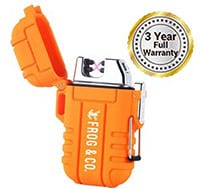
- Will your cheap BIC work after dropping it in a river? Nope.
- Will it’s flame stay lit in 80 MPH winds? Not a chance.
So it’s worth a few dollars on better lighter technology:
Like Tesla’s Rechargeable Coil Lighter.
This lighter doesn’t use liquid fuels.
So you’ll never run out.
It uses electricity to create an arc that’s windproof and waterproof.
It charges via a USB port.
So with a solar charger or a hand crank radio you can make your own “fuel.”
37. Tinder
You CAN find natural tinder in the wilderness.
However, it’s always smart to prepare for the worst.
So pre-pack some fire-starting tabs.
Cotton balls dipped in petroleum jelly will work as well.
38. Vaseline
Add a dab of Vaseline to some cotton balls, which ignite quickly and easily.
39. Fresnel Lens
You can use magnification to focus light.
This light can be harnessed to make a fire.
A Fresnel Lens will work if you run out of butane or matches.
Super lightweight solar fire starter? Sign me up!
↓ How To Start A Fire With A Fresnel Lens
40. Small Waterproof Storage Container
Stash all your fire-starting tools into an O-ring-sealed container.
This container keeps your fire-starting tools dry.
Even in a downpour or if you fall into a river with your pack.

Want a free 104 item bug out bag checklist?
Click here to instantly download this Complete Checklist PDF. No purchase necessary.First Aid & Medical Supplies
In the elements, there’s an increased chance of illness or injury.
So add some first aid supplies.
Remember:
A minor cut can kill if not properly treated.
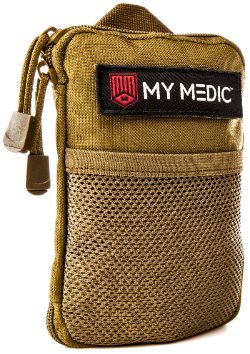
I recommend you get a MyMedic Advanced Solo Kit.
It’s the best compact medical kit I’ve ever come across.
It’s perfectly designed bugging out.
It includes exactly what you need – no more, no less.
But this kit IS NOT just a bunch of cheap medical supplies.
- The pouch is high quality
- It’s MOLLE compatible.
- The supplies are all excellent.
So you can easily check off all your medical supplies with one purchase.
Much faster and easier than buying each individually.
Note: Choose a pouch color that blends in with your bag and environment.
For bugging out you want to avoid the bright red pouch.
NOTE: The MyFAK (First Aid Kit) option includes even more lifesaving medical gear and supplies.
But it also weighs a few more pounds (1 lb. vs. 2.8 lbs.)
41. Personal Medications
If you take prescribed medications, add them.
42. Wound Gauze Roll
Gauze dresses bad cuts or severe burns.
It’s light and takes up very little space.
43. Surgical Tape
This stuff is made to keep gauze, pads, and bandages in place while on the move.
44. Band-Aids / Mole Skin Pads
Band-aids are the best solution for small cuts and lacerations.
They keep open wounds clean and protected.
This prevent an infection.
You should also add a few moleskin pads for blisters.
Band-aids won’t stay in place while walking.
But moleskin will.
45. Antibacterial Cream
Add this cream to any cut or laceration to prevent infections.
46. Pain Killers
For minor aches and pains, these can keep you going.
Painkillers will take the edge off of serious injuries until you can get more help.
47. Blood Clotting Sponge
Nasty, deep wounds struggle to clot on their own.
You must apply intense pressure to the wound site for a long time.
Only then the flow will slow, congeal, and begin the healing process.
These Quick Clot Sponges help with this life-or-death effort.
48. Super Glue
Super glue seal up small cuts.
Plus, it comes in handy for numerous survival uses.
49. Vaseline
I’m aware this is the second time Vaseline made this list.
But it works as a fire starter and an ointment.
Apply this stuff to your chapped skin or lips to prevent cracking.
50. Survival Antibiotics
When SHTF, access to lifesaving antibiotics will become severely limited (if available at all).
So stock up on bird or fish antibiotics and throw them in your go bag, just in case.
51. Sterile Alcohol Prep Pads
Clean all wounds with these alcohol wipes.
They kill infection-causing bacteria.
52. Hydrogen Peroxide
Same idea as the alcohol pads; use them to keep wounds clean and bacteria-free.
53. Q-tips Cotton Swabs
Use Q-tips to clean your ears.
Excess ear wax can lead to infection.
And muffles your hearing.
And clear hearing is an advantage in survival.
They are also ideal to apply medical salves and liquids.
Lastly, you can tear off the ends and use them as tinder.
Plus, they’re extremely light and useful.
So feel free to pack a couple hundred.
54. Tweezers and Nail Clippers
Pack a sharp set of tweezers to get slivers out.
And a good set of nail clippers to trim your nails.
55. Insect Repellent
Mosquitos are a nuisance and can transmit diseases.
So pack a repellent spray with high amounts of DEET.
56. Sun Screen
You should only pack a small bottle of this.
So you’ll need to ration it.
A hat, long sleeves, and pants go a long way to prevent sunburn.
Get one with an SPF30, like this one.
Higher SPFs are just a marketing ploy.

Want a free 104 item bug out bag checklist?
Click here to instantly download this Complete Checklist PDF. No purchase necessary.Personal Hygiene Items
If you enjoy daily hot showers, get ready for an abrupt change.
You’ll only get basic sanitation when on the run.
57. TP | Moist Towelettes
Add a small roll of toilet paper for doing your business.
And add a bunch of these shower wipes.
They are a good lightweight hygiene solution on the go.
It’s no shower, but it’s better than nothing.
58. Mini-Toothbrushes
Oral hygiene is important to prevent all sorts of tooth problems.
Dental work will be rare after TEOTWAWKI.
So it’s worth preventing painful tooth problems in the long run.
Pack a couple small, light toothbrushes.
Because they don’t take up much space.
59. Mini-Toothpaste Tubes
Some mini toothbrushes come with a dab of paste built-in.
But you’ll want to use them more than once.
So you need a small tube of toothpaste.
Ration it to the extreme.
You don’t know how long it will be before you can restock.
But try to use a little each day.
60. Dental Floss
Light, small, and highly useful.
Dental floss will keep your gums healthy. Maybe even more important than brushing.
61. Sportsman Soap
While moist towelettes can replace your daily shower, you’ll want some sportsman soap for the occasional river bath.
Again, ration this stuff to the extreme unless you pack a lot of it.
But it will get heavy and take up space if you do.
62. Tampons
Everyone should add a few of these to their packs since there are 13 excellent survival uses for tampons.
63. Hand Sanitizer
Use a small bottle of hand sanitizer to clean your hands before eating.
Try to avoid ingesting bacteria after tromping through the wilderness all day.
64. Bandana / Face Shield
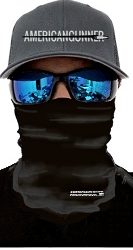
For personal hygiene, use it to wipe and clean.
You can also use it as a makeshift dust mask.
OR even better, you can wear a cloth face shield like this one by American Gunner.
This cloth face shield provides the following:
- Ultimate UV Protection
- Protection From Wind & Snow
- Lightweight & Breathable
- Perfect For Hunting, Fishing, Biking & Bugging Out
- Protection From Insects
- One Size Fits All
- Moisture Wicking Material
Core Survival Tools
These are traditional survival tools that didn’t fit into our other checklist categories.
However, they are essential to success.
65. High-Quality Compass
Navigation is critical.
Getting lost is dangerous.
Everyone should own a high-quality compass and learn how to use it.
Knowing where you are is the best way to reach your final destination.
Learn how to use a compass (and keep it with you), and you’ll never get lost again.
GPS devices run on batteries, so you can’t rely on them in a bug out situation.
66. Tough Compact Folding Shovel

You can also improve a shelter by clearing and leveling the ground.
A tactical shovel allows you to complete even more survival tasks such as:
- Digging
- Chopping
- Sawing
- Pickaxe
- Trenching
- Etc.
This one does all that (and more) …
67. Survival Knife
I can’t stress how important investing in a high-quality survival knife is.
Don’t be foolish and use a credit card knife for a bug out!
Spend some time researching good survival knives.
Find one that best meets your needs.
Because a good survival knife has many critical survival uses.
Then once you’ve settled on “the one,” make sure you learn how to use it in the wild.
Don’t forget to add a small survival knife sharpener to keep your knife sharp.
NO serious survivalist would ever allow their survival knife to become dull and useless.
68. Survival Series Multi-Tool Pliers
A survival multi-tool is another key survival tool to pack.
The pliers are the biggest difference between a multi-tool vs survival knife.
These survival pliers allow you to perform many functions that would be impossible with a knife alone.
69. Light-Weight Rugged Solar Charger
From flashlights to GPS units to cell phones, technology may be in your emergency kit.
AND they’re all worthless without electricity!
So add a solar charger and battery pack if you depend on those items.

Why? Because it’s one of the most durable, compact, and cost-effective portable solar chargers on the market today.
But don’t let its compact size fool you.
It’s got a massive 10,000 mAh battery capacity!
The battery storage is enough to charge any of your devices multiple times over.
Plus, with dual charging outputs, you can power multiple devices simultaneously!
Simply plug in your devices via the supplied USB cable (you can use any USB cable) and press the power button.
Your device will begin to take power from the Anytime Charge right away.

Leave it in the sun, and it will automatically fill the large battery bank back up ANYWHERE.
Plus, it’s splash resistant and comes with an emergency flashlight with a strobe function.
70. Survival Hatchet
Survival hatchets are awesome.
They allow you to accomplish tasks quickly that using your survival knife alone would take hours.
A good survival hatchet makes batoning branches for firewood a breeze.
It makes chopping down trees a whole lot faster too.
Plus, these survival tasks are hard on your survival knife.
But a hatchet handles with ease.
Get one of the lightest ones you can find.
↓ Fiskars X7 Long Term Review
71. Small Wire Saw
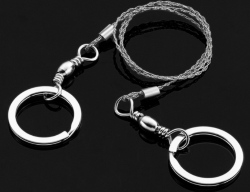
This wire saw cuts down small trees to help build shelters!
Watch the video below to see how to turn a clunky wire saw into an efficient cutting machine:
↓ I HATED Survival Wire Saws – Until NOW!

Want a free 104 item bug out bag checklist?
Click here to instantly download this Complete Checklist PDF. No purchase necessary.Illumination Tools
Illumination is necessary for survival.
You’ll need good light to work under the darkness of night.
And if forced to move in the middle of the night, you’ll need it to see where you’re going.
I can’t imagine bugging out without illumination devices.
Attempting to do so would be stupid.
72. Super Bright LED Headlamp
Two words: Hands-Free.
I recommend getting one with lots of modes, as well as rechargeable batteries.
And with the rechargeable batteries, you’ll need a way to recharge them.
That’s where a portable solar charger comes in handy (item #69 in this checklist) to keep your LED headlamp batteries charged up.
73. Super Bright LED Tactical Flashlight
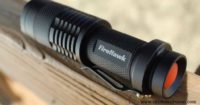
You have more control with a handheld LED flashlight.
And can shine it in multiple directions without having to turn your head.
I prefer using a Tactical flashlight if I’m not using my hands to accomplish a task.
Check out the FireHawk Tactical Flashlight that you can get for free by simply covering the reasonable S&H.
↓ Get A FREE FireHawk Tactical Flashlight (+S&H)
74. Glow Sticks
Glow sticks work great to light up an entire area, not just a particular spot.
Which can be very helpful in a campsite.
However, they can give away your position to potential threats.
So only use these if you know you’re in a secluded area.
Or use a solar lantern you can turn on and off when you’re not in a secure area.
Here are 10 survival uses for glow sticks.

Want a free 104 item bug out bag checklist?
Click here to instantly download this Complete Checklist PDF. No purchase necessary.Communication Devices
Gathering information and sharing information during a bug out situation is critical for success.
Whether it’s a severe weather forecast or knowing the location of potential threats…
The more you know, the more you can plan and adapt on the go.
If you’re in a small coalition, you’ll want to communicate with each other over short distances.
Useful if you get separated or planning an ambush.
75. Hand Crank Radio
You’ll want regular updates on how the “situation” is progressing.
This helps to decide your next move.
Providing confidence, you’re heading away from danger (and not into it).
The big advantage of a hand-cranked radio is that you won’t need to worry about batteries.
Plus, you can use the hand crank function to charge other small electronic devices.
Bugging out and then having no way to get intel is flying blind.
Here’s a video review of a similar hand crank radio from Jason (Skilled Survival’s gear expert):
↓ Hand Crank Radio Review – Eton Microlink
76. Two-Way Walkie Talkie Radios
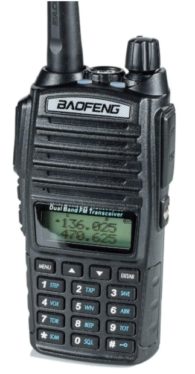
If your team gets separated, you’ll still be able to keep in touch at short distances.
Recharge your walkie-talkies with your solar charger or hand-crank radio.
77. Protected Smart Phone
You should never solely rely solely on a cellphone for your survival.
Yet, if you take your smartphone with all its apps and information, get a hard protective case for it.
I have an otter box case that protects it from abuse.
Recharge your phone using a solar charger or your hand-crank radio.
78. Small Signaling Mirror
If you’re bugging out, you’re not interested in being rescued.
Odds are you’d rather not draw any attention your way.
However, use a small signaling mirror to communicate with your fellow companions at longer distances (instead of using walkie-talkies).
If you learn Morse Code, you can use long and short bursts of light to communicate.
79. Notepad and Pencil
Go old school with a pencil and paper.
You can leave notes or send mail (if there’s still mail service).
Both are light and small.
So find some room in your bag for them.
80. Multi-Functional Survival Whistle

Again, it’s light and takes up very little space.
Self Defense Tools
In the worst survival conditions, you’ll be the hunter (or hunted).
Prepared to defend yourself and your group from threats.
Threats from wild game.
And threats from other humans…
81. Survival Firearm
Which firearm is best for bugging out?
To be honest, you could write an entire survival book on the subject.
It’s a very personal choice with lots of nuances to consider.
For bugging out, you need a firearm that is designed to break down.
That way, it can fit in a pack.
I also prefer a rifle to a handgun.
And as far as ammo weight goes, it makes the most sense to go with .22LR.
So with that said, you should consider one of these three .22 takedown rifle options:
Three Great Takedown Survival Guns.
82. Firearm Ammunition
Ideally, you want to carry enough ammo to avoid rationing.
But you have to watch your weight.
For example:
- 200 rounds of 44 magnums weigh about 9.14 lbs.!
- On the flip side, 200 rounds of 22LR only weigh 1.5 lbs.!
That’s why I’m packing 22LR and adding a good takedown rifle.
You could also cache ammo on your bug out route.
Here’s a list of different calibers and their respective weights.
This can help you research this important issue further…
83. Taser
You could stash a Taser as an alternative to using a firearm for self-defense.
Remember:
There’s no such thing as a fair fight when SHTF.
You might not start a fight, but be prepared to end one.
84. Survival Bow Or Cross Bow
Here are just a few of the significant advantages of a takedown survival bow or crossbow:
- Arrows are reusable, so you won’t need to pack as many as you would ammunition
- Bows are silent to shoot, especially in comparison to a firearm
- Takedown bows fold down and can easily fit in backpacks
- Recurve bows don’t have complicated parts, so they are easy to shoot and repair
- Strong enough to take down small and large game
Here’s a good review video on one of the best survival bows (the Samick Sage Takedown Bow):
↓ Samick Sage Takedown Recurve Bow Shooting ↓
85. Pepper Spray
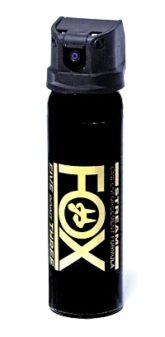
It was about a man hospitalized after eating one Carolina Reaper.
It is said to be the hottest chili pepper known to man.
It’s been rated at around 2,000,000 Scoville Heat Units!
This pepper causes intense dry heaves, blinding headaches, and some near-stroke symptoms.
But what if the “pepper” in a pepper spray was that powerful?
FOX Labs is measured at 5,300,000 SHU – an astounding 265% hotter than the Carolina Reaper!
It can spray this blinding defense up to 17 to 20 feet.
FOX Labs Pepper Spray is used by Police, Law Enforcement, Security, and Military agencies worldwide.

Want a free 104 item bug out bag checklist?
Click here to instantly download this Complete Checklist PDF. No purchase necessary.Misc. Survival Tools & Supplies
Finally, these are the random survival tools and supplies that will make your bug out a little bit easier.
86. Carabineers
To effectively utilize your bag’s MOLLE system, you need a good set of carabineers.
Clip them to your bag’s MOLLE and hang gear from your pack.
This system helps to add a lot of “extra” gear to the outside of your pack.
And saves space inside your bag for other supplies.
If you only want to hang gear, you can get cheap carabiners.
Theses are NOT for climbing or lifting objects.
If you need that, invest a few more dollars and get ones made for that.
87. Rechargeable Batteries
Add a couple of sets of these rechargeable batteries.
Pair these up with your portable solar charger.
Then you’ll be able to keep your batteries charged from anywhere.
88. Cash or Precious Metal Coins
It’s anyone’s guess what currency will be in circulation after SHTF.
But it’s always good to have some precious metal (silver and gold) for trading, purchasing, or bartering.
89. Playing Cards
A set of survival playing cards can help keep spirits high.
And you might as well get ones with survival information on them.
90. Tactical Sunglasses
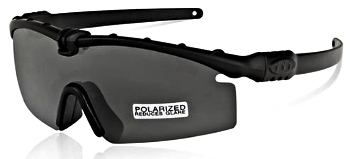
If you’ve ever experienced a case of snow blindness, you know how important a pair of shades can be.
Get a pair that won’t shatter or scratch when bugging out.
And these Milspec Tactical Eyewear™ are “field-tested and ready to go out of the box.”
They come with 4 interchangeable lenses, a tough storage case, and much more.
↓ MILSPEC Ballistic Magnum
91. Personal Credit Cards
These thin pieces of plastic will most likely end up being worthless.
But then again, they might be useful at some point when society recovers.
Credit cards are another small, light object you can add to your go bag.
As a side note, we recommend carry your credit cards in an RFID-blocking wallet in good times and bad.
Check out our Tactical Wallet Article for more information.
92. Driver’s License / Passport
Similar to credit cards, these items may or may not be useful, but they might be good to pack, just in case.
Also, like your credit cards, it’s best to carry your passport in an RFID-blocking case.
Unless you’re trying to disappear completely.
93. Small Roll Of Duct Tape
There is a lot of survival uses for duct tape.
For a list of 25 of these applications, check out The Daily Sheeple’s 25 Survival Uses For Duct Tape.
It’s a smart addition to your go-bag list.
↓ 10 Genius Uses For Duct Tape In a Survival Situation
94. Local Area Topographical Map
To avoid trouble, you have to know exactly where you are and where you’re heading.
So invest in a high-quality waterproof map of your local region.
And learn how to read topo maps while you’re at it!
95. Gas Mask
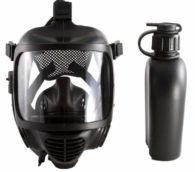
Without one, you’d be forced to breathe contaminated air.
Check out MIRA Safety OR Parcel Distribution, as these two vendors have the Best Gas Masks on the market today.
I bought the CM-6M mask and several filters for myself.
I prefer its wide viewing angles and durable construction compared to other gas masks I reviewed.
NOTE: If you wear glasses, you’ll definitely want to add the MIRAVISION Spectacle Kit.
That way you can ensure a proper seal on your gas mask AND see clearly.
↓ MIRA Safety CM-6M Gas Mask Review
96. Camo Face Paint Sticks

The natural color of pale skin sticks out like a sore thumb in the wild.
However, face paint will attract unwanted attention if traveling through civilization.
So only use it in environments where it makes sense.
97. Family Photos
Family photos can be useful to help track down separated loved ones.
Having an image to show strangers can help get better information on their whereabouts.
They also can help you remember loved ones which you may have lost.
98. Set Of Broadheads
Broadheads can create basic spears for hunting or self-defense.
They are lightweight, small, and ideal for gigging or spearing.
99. Spare Pair Of Corrective Lenses
If you wear corrective lenses, add a second pair.
Store them in a hard protective case to keep them from breaking in your pack.
Trying to survive with impaired vision is a significant disadvantage.
100. Mosquito Head Net
A mosquito head net can provide relief if you are bugging out.
As we know, mosquitos are both a major annoyance and transmit diseases.
101. Survival Watch
Get a survival watch that recharges itself using solar power.
While there are some tactical watches worth every penny.
Here’s the survival watch I own.
102. Electrical Tape
Electrical tape has a lot of worthwhile survival uses.
Find some pack space for a small roll.
The stuff stretches and sticks; there’s really nothing quite like it.
103. Trekking Poles
If your bug-out plan includes elevation changes, add a good pair of anti-shock trekking poles.
They help relieve stress from your legs and knees.
104. Best “Done For You” Bug Out Bag
Perhaps you’re overwhelmed at the idea of building your own BOB.
I get it, it IS overwhelming if this is all new to you.
If you’d prefer to make a single purchase with all the basics, check out this Go Bag from MyPatriotSupply:
The Ready Hour Go-Bag Includes:
- (1) Black Tactical Backpack
This durable backpack is resistant to tears and abrasions. It features a variety of mesh slots, pockets, and zipper compartments to store your survival supplies.
- (1) Ballistic Panel
Insert this 8 in. x 10.5 in. ballistic panel into your backpack for extra protection from whatever may come your way. This panel fits perfectly into the pack pocket against your back and has a five-year shelf life
- (1) Emergency Sleeping Bag by Ready Hour
When you’re caught in dangerous weather, use this reflective bag to keep your body temperature comfortable and stable. Waterproof and wind resistant, it can also be used as ground cover or gear protection.
- (1) Army Green Nylon Emergency Tent with Survival Whistle by Ready Hour
Keep yourself (and your gear) warm, dry, and protected from harsh conditions with this thick, tear-resistant tent. At pocket size, it can shelter two people. Comes with paracord and survival whistle.
- (1) Aquamira G2O Water Filtration Bottle
Not sure about your water supply in an emergency? Fill up the Aquamira G2O Bottle to reduce chlorine, VOCs, microplastics, and harmful chemicals, as well as remove parasites, bacteria, and viruses**. Filter up to 120 gallons of water with each replaceable filter.
- (1) Rechargeable Sensor Headlamp by Ready Hour
Fully-Rechargeable, Motion-Activated Headlamp Provides 20 HOURS of LIGHT!
- (2) 2,400 Calorie Emergency Ration Bars by Ready Hour
Get quick calories with 12 tasty bars. At 200 calories each, you’ll have 2,400 calories in one box! Tastes sweet like a shortbread cookie.
- (8) Emergency Drinking Water Pouches by Ready Hour
Packed in sturdy, puncture-resistant pouches with four protective layers, you can count on this emergency drinking water in your backpack—and hydrate when water is nowhere to be found.
- (1) Survival Kit with Guide (46 Pieces)
This kit was made for crisis. From first aid essentials to fishing supplies, it’s a survival kit with a little bit of everything—plus a helpful guidebook.
- (1) Waterproof Matches (4-Pack) by InstaFire
Start a fire with a single strike. These waterproof matches can be lit to provide light, keep you warm, and cook your food in nearly any conditions.
- (2) InstaFire Fire Starter Pouch
This simple fire-starting product can produce a fire in five to ten minutes in wind, rain, and snow. Light with a match or lighter to cook your food or keep yourself warm.
- (1) Ready Hour Patch by Ready Hour
Add this patch to your pack to make it stand out from the rest.
- (1) Emergency Poncho (2-Pack) by Ready Hour
Whether it’s a small shower or even a downpour, this two-pack of one-size-fits-all ponchos will keep you warm and dry. Lightweight, durable, and reusable, they can be folded into a small size to save space.

Want a free 104 item bug out bag checklist?
Click here to instantly download this Complete Checklist PDF. No purchase necessary.Final Words Of Advice
My final word of advice is to take action today.
Using this bug out bag essentials list to get the gear you don’t already have.
If you don’t already have a go bag, invest in one today.
Those of us serious about prepping know disaster strikes when we least expect them.
Whether it’s a natural disaster or a man-made one.
If you wait, it might be too late.
Why Trust Skilled Survival...
Go here now to review a full breakdown of:
- Who We Are
- Our Credentials
- Our Mission
- & Product Recommendations...
Here are a few highlights of our teams credentials & certifications:
- Certified Member of a Mountain Search & Rescue Organization
- Plant Emergency & Safety Leader for a Major Food Manufacturer
- Member of the 10TH Mountain Division Hut Association
- Certifications: Avalanche 1, WFR, CPR
- Official Gear Tester for Numerous Outdoor Gear Companies
- Countless Multiday Backpacking trips into Remote Wilderness
- Bachelor's Degree In Mechanical Engineering
- Bachelor's Degree In Civil Engineering
- Bachelor's Degree In Biomedical Engineering
"It takes 20 years to build a reputation and five minutes to ruin it." - Warren Buffett
We're fully aware that trust is NOT something you GET but is EARNED.
And we'll continue to earn YOUR trust through our forthright and honest approach with each new Blog Post, Guide & Product we create...
Prepare, Adapt & Overcome,
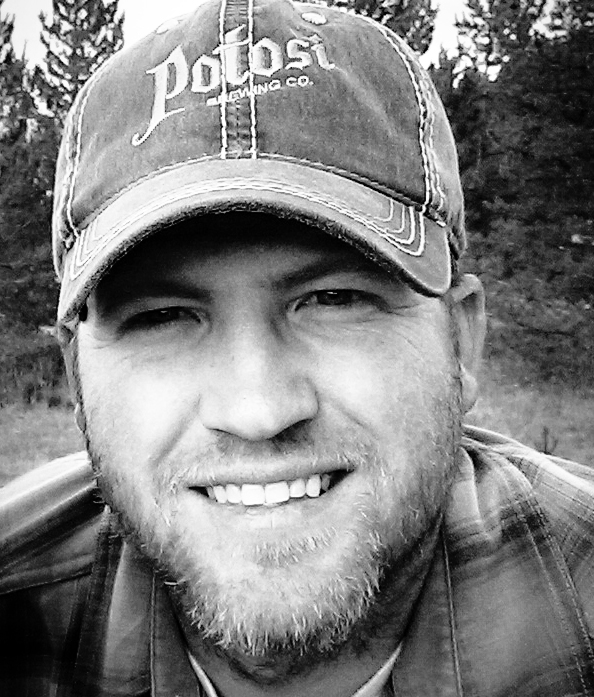
P.s. Do You Live In A 'Danger Zone' County?
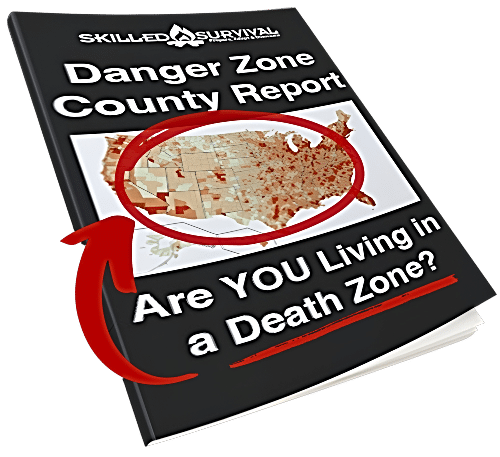
Find out now using my Danger Zone County List & Special Report it’s absolutely FREE.
In minutes you’ll know EXACTLY where you stand and if you should be worried or not..
So click here to get my FREE Danger Zone County List & Report…

Recommended Reading
Best Bug Out Bags: The Most Reliable Pack Experts Trust
You deserve a bug out bag you can trust; a pack to protect all your gear. Here's how to find a good one and avoid making amateur mistakes.
Bug Out Bag Weight: How To Reduce Every Deadly Pound
10 advanced tactics to reduce your bug out bag weight because a heavy bug out pack will slow you down. And a slow getaway can get you killed.
Bug Out Location: Finding A Perfect One You Can Afford
There are 7 must-have qualities for a perfect bug out location . I show exactly what they are and how to find an affordable one in minutes...
Bug Out Vehicles: The Best Setups To Escape The Chaos
A good bug out vehicle will help you make it out of chao to safety FAST. I show you the best options and capabilities to design your own rig.
Valley Food Storage Review: An Expert Puts It To The Test
Unbiased and thorough Valley Food Storage review covering food supplies, packaging, taste, and shelf life. Don't buy without reading this...
Bug In Vs Bug Out? Smart Or Guaranteed Death Trap
One of the hardest SHTF decisions is: Bug In vs Bug Out. You should plan for both because there some situations where you may have to leave.










